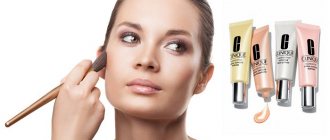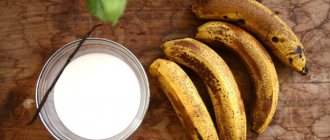Even if you are an avid cosmetic minimalist, you probably use foundation or powder. Choosing foundations can be difficult, because each brand has its own color palette. I suggest you understand the color designations that are most often found, as well as how to choose the right foundation. Let me say right away that this is my personal opinion and vision, you may not agree with it.
Foundations differ not only in brightness - from light to dark, but also in the color itself - yellowish, peach, pink, grayish. To make it easier to understand, let’s start with a little “educational education”.
In colorism, there is the concept of warm and cold shades of the same color. For example, yellow can be both warm (yolk is a great example) and cold (lemon). It’s not at all difficult to distinguish one from the other: it’s as if a drop of red or orange was added to warm colors, and blue to cold ones. Here are some examples of such colors:
Left - warm, right - cold
Left - warm, right - cold
Left - warm, right - cold
However, there are also neutral shades in which warmth and cold are balanced. With them, everything is a little more complicated, but if you look at neutral shades in comparison with the previous two categories, then everything becomes clearer.
On the left is warm, in the middle is neutral, on the right is cold. They are all the same color at different temperatures. Cool red seems much pinker and lighter compared to the others. These are already features of the perception of color by the eye.
Cool (pink), neutral and warm (yellow) beige look like this for most foundation brands
And one more category of shades, which is found exclusively in foundations and is, in my opinion, the most difficult. These are neutrals with warm or cool undertones. How so? It looks approximately as if just a little warm or cold shade was added to a neutral color. It cannot be called distinctly warm or cold, but it is also neutral - it is in the middle. This category is found mainly in brands where the color palette of products is very wide.
Warm and cool colors
It all starts with the color wheel, which in its classic form consists of 6 colors that repeat the color of the rainbow, only blue and blue in the color wheel are combined into one, since in fact they are variants of the same color with different saturation:
- red;
- orange;
- yellow;
- green;
- blue;
- violet.
Between the 6 cells of the color wheel there are intermediate colors - between red and orange - red-orange, between yellow and green - yellow-green. Each color of the circle has its own temperature.
Color temperature may vary:
- warm. These include colors in which yellow predominates in the undertone;
- cold. Here blue becomes the key in the undertone.
It’s like with lamps - there is cold light - it is light, it gives off blue, and there is warm light - it gives off yellow or even orange light.
But not everything is so simple. If you make the color circle a little wider and add intermediate shades to it, you will notice that different tones of the same color can have different temperatures.
For example, green. In the color wheel it is between yellow and blue, that is, it is borderline between heat and cold.
If we take a turquoise shade of green, we get a typical cold color, because the predominance of blue in it will be higher than yellow. And if you consider lime - a mixture of yellow and green, you get a great warm shade.
Same thing with red. Raspberry is cooler, while scarlet is much warmer.
This happens due to the already mentioned undertones. An undertone is an additional shade that is not immediately perceived by the eye. A subtone is formed after adding an additional color to the main color, for example, purple to red. It is the undertone that determines the temperature of the skin, cosmetics, and clothing.
The ability to distinguish warm colors from cold ones is useful in choosing cosmetics and clothes, so it’s better to figure it out once and always match the tone of an eyebrow pencil or any other cosmetic product.
About color combinations in manicure and more >>.
Why does everyone have a different shade?
It is almost impossible to give an exact answer to this question, since today there are many hypothetical reasons for differences in the colors of human skin, the most popular of which are the following:
- Amount and intensity of sunlight (highest in Central Africa).
- Relocation of peoples to other, colder parts of the Earth.
- Gradual loss of body hair as evolution progresses.
- Adaptation to other climatic conditions.
How to determine skin temperature
First, let's decide on the skin tone temperature, and in the next section we'll talk about color types in general.
And so, unlike the color wheel, external temperature has three varieties:
- warm – with a predominance of yellow;
- cold – with a predominance of blue;
- neutral – when there is no pronounced color.
To determine the temperature, you can endlessly examine your face and skin in search of the right shades, but it is much easier to carry out a few simple tests:
- Look at the veins in the wrist area where the IV is usually placed. If the veins are bluish, then you are a cold type, if they are green or greenish-blue, then you are a warm type;
- Remember how your skin behaves when you try to tan. “Warm” girls almost never burn out, while “cold” girls do it very quickly. If the skin has a warm tone, the tan will apply evenly and without much effort. “Cold” skin remains pale even after burning;
- Use a white sheet of paper. In natural light, go to the mirror and hold a clean sheet of bull paper to your face. The contrast will show which tone predominates in your skin - if pinkish is a cold type, yellowish is warm;
- Gold and silver flap. Take a small strip of silver and gold fabric or foil and wrap it around your wrist. The right flap will complement the skin and fill it with pleasant color, while the wrong one will make it look painful. Gold here acts as heat, and silver as cold.
Blue face
The blue color accompanies life-threatening heart or lung diseases, or covers the face when taking certain medications.
Blue face as a result of treatment
A drug such as Cordarone can turn the face blue. In this case, you need to consult a cardiologist about reducing the dosage of the medication.
The second cause of ceruloderm (as doctors call blue skin) is the use of silver preparations, mainly for antiseptic purposes, for example, for a runny nose. People involved in silver processing also get sick. This condition is called argyria and usually leads to damage to the bone marrow, eyes, kidney failure and damage to the nervous system - silver salts accumulate not only in the skin, but also in all internal organs, vessel walls, mucous membranes, sclera of the eyes, and remain there for the entire life.
If a person stops using medications containing silver salts, the symptoms of damage to internal organs will go away, but the blue color of the skin will remain.
Methemoglobinemia
This is the name of the condition when normal hemoglobin is replaced by an altered one - methemoglobin, in which iron is not divalent, but trivalent, and cannot carry oxygen. This disease most often appears during poisoning with hemolytic poisons. For example, it occurs with an overdose of Paracetamol, the use of long-stored Phenacetin and sulfonamides, as well as in cases where large amounts of nitrates and nitrites are ingested in food (they are found in well and tap water, in canned meat, in fruits fertilized with nitrate-nitrite fertilizers and vegetables). There are also hereditary forms of pathology.
For any form of the disease, the symptoms will be as follows:
- the skin acquires a gray-blue tint;
- the nail phalanges do not change their shape (if the heart or lungs are affected, the nail-bearing phalanges expand, taking on the appearance of “drum sticks”);
- physical activity is accompanied by shortness of breath and fatigue;
- headaches are frequent and severe.
Cardiopulmonary diseases
These pathologies cause both generalized cyanosis, when the whole body acquires a bluish tint, and regional cyanosis, manifested by blueness of the skin under the nails, the tip of the nose, lips and nasolabial triangle.
This condition develops in various diseases:
- Heart failure . In this case, there is pain in the heart during physical activity, shortness of breath at rest, which increases with physical activity, and swelling, localized mainly in the legs. An ECG or ultrasound of the heart can determine the disease that caused this pathology.
- Asthma attack . Here, the appearance of an attack can be associated with an encounter with an allergen (for example, plant pollen or household chemicals), there is a dry cough, it becomes difficult to exhale, and sometimes wheezing can be heard from afar.
- Pneumonia . It is not always, but often manifested by cough and fever. In addition, there is shortness of breath, a feeling of lack of air, weakness, and nausea.
- Cyanotic variant of erythrocytosis.
- Tuberculosis . In this case, a cough is noted: it is dry, sometimes during a cough attack a certain amount of mucous sputum is released. The temperature rises to low levels (up to 38 degrees), weakness and increased fatigue are noted.
- Pulmonary embolism: when one or more branches of the vessel leading from the heart to the lungs develops a “congestion” or blockage with a blood clot, fat, gas, or masses detached from the inflamed heart valves. The disease develops abruptly: often after straining or performing heavy physical work, a person with varicose veins, heart defects or an aneurysm suddenly develops weakness, shortness of breath with a feeling of lack of air. A little later, a cough and pain in one of the halves of the chest develop.
- Any type of shock , manifested by a sharp decrease in blood pressure. Shock can develop with significant dehydration, large amounts of bacteria entering the body, blood loss, severe pain due to injury, or anaphylaxis.
- Heart defects . Often, only fatigue is subjectively felt; there may be rhythm disturbances and headaches. The upper half of the body may differ in color from the lower.
- Chronic bronchitis . It manifests itself as a cough, fever, and sometimes a feeling of shortness of breath. If a person has had this disease for a long time, his fingers change: the nail phalanges thicken, becoming like “drumsticks.” Nails also change: they become dull, they are covered with grooves (such nails are called “watch glasses”).
- Pleurisy . This condition develops after pneumonia. It is characterized not only by the development of a bluish coloration of the skin, but also by a repeated increase in body temperature that has already returned to normal, chest pain when breathing, chills, weakness, and night sweats.
- Pneumothorax . This term characterizes a condition when, due to injury to the lung, air penetrates into the cavity surrounding it. If the amount of air increases, then it compresses the lung itself and the heart lying nearby. Is it dangerous. The pathology develops acutely, usually after physical effort or a coughing fit. Severe pain appears on the side of the damaged lung, which intensifies with deep inspiration, coughing and movement. Shortness of breath and a feeling of lack of air also appears.
Determination of color type
A color type is a set of color characteristics of appearance that determine the classification of a person’s appearance into one of four types:
- spring;
- summer;
- autumn;
- winter.
The correlation of color types with the seasons is not accidental, because each period has its own special colors, unique only to this time. Moreover, the air temperature is not the determining factor here, but more on that later.
Participate in determining the color type:
- leather;
- hair;
- eyes;
- contrast of the above criteria.
We described above how to determine skin temperature. Now let's look at the remaining criteria.
Hair
When assessing hair, you need to take into account the shade, not the color, because as we said at the beginning, the same color in different shades can be warm or cold . It is also important to consider that you need to evaluate the natural color - only it will give an objective picture.
Warm hair tones include golden and reddish, and it doesn’t matter what the main color of the hair is.
“Cool” hair is defined by the exclusion of golden and red tones from its undertone. For example, ash blondes do not have gold or red in their hair, so they are “cold.”
There are exceptions when even on ashen hair notes of red or gold are visible. This means that when determining a color type, you need to analyze other criteria.
Eyes
Determining the temperature of the iris is not an easy procedure, since it is difficult to imagine obviously warm or cold shades in this matter, but it is worth additionally analyzing the color of the iris, perhaps you are the owner of a unique shade.
Warm ones include:
- amber;
- gold;
- olive;
- light brown.
To the cold:
- gray with a steel tint;
- ice blue;
- bright blue;
- dark brown without inclusions.
The eye shades listed above are rare, so they cannot be the main criterion for determining eye color type.
Contrast and color type
Let your hair down and look in the mirror. It is advisable that there is no makeup on the face that distorts the naturalness of the skin.
- skin and hair contrast. A striking example is natural brunettes with porcelain skin;
- skin and hair have something in common. For example, red hair and skin with a golden tint.
From the collected criteria you can collect 4 combinations:
- Cold type and contrasting appearance;
- Cold type and overlapping appearance;
- Warm type and contrasting appearance;
- Warm type and matching appearance.
Winter
If at the stage of determining the temperature you find out that your skin tone is cold and your hair contrasts with it, then you belong to the “winter” color type. People with this color type usually have dark hair, both black and brown or chestnut, as well as light skin and bright eyes - green, blue, dark brown without gold inclusions in the iris.
Selecting cosmetics for the Winter color type >>
Summer
If the type is cold, but the whole image looks laconic, you belong to the “summer” color type. Summer girls are distinguished by cool hair color and the same skin. Most often, the hair has an ashy tint, and the skin is pinkish or olive-gray.
Selecting cosmetics for the Summer color type >>
Autumn
With a warm tone and a contrasting image, you are “autumn”. Autumn girls are distinguished by hair of copper, red, red shades and golden skin. The eyes are most often brown, but not dark - hazel, amber.
Selecting cosmetics for the Autumn color type >>
Spring
Spring is girls of warm tones with overlapping appearances without contrasts. Light skin and hair are the main characteristic. The eyes are also usually light. Even if the iris is brown, their shade will definitely be warm.
Selecting cosmetics for the Spring color type >>
What determines the color of the skin?
The color of human skin is determined by a special pigment - melanin, which is produced by special cells - melanocytes. Melanin production depends on the following factors:
- Genetic predisposition.
- Ultraviolet radiation intensity.
- Gender of the person (the skin of female representatives is always slightly lighter than that of males).
- Time spent in sunlight.
- The amount of hormones that stimulate the production of melanin and ACTH.
However, there are people in the world who completely lack melanin in their skin cells. They are called albinos. It is contraindicated for such people to stay in the sun for a long time, as they are immediately susceptible to strong radiation.
What pigment determines intensity?
In addition to melanin, the shade of a person’s skin is determined by several more pigments, which also determine the tone and color type of the dermis:
- Carotene. Characteristic of all skin colors, it is responsible for the production of yellow shades. It is difficult to visually determine the level of carotene in the skin, since it is hidden by melanin. Residents of the eastern part of Asia have the highest levels of carotene, which is why they have a yellowish tint to their dermis.
- Hemoglobin. Responsible for giving the skin, in particular the cheeks, a pinkish tint. Hemoglobin is most noticeable in people with fair skin.
The results of color analysis of the dermis depend on the amount of each of the three pigments in the body.
Decorative cosmetics by color type
Eyebrows should match the color of your hair, eyes and skin. To accurately match the tone and not give away artificially created eyebrows, you need to know the temperature of the skin.
Summer
For a summer color type, eyebrows should be cool, matching the hair. Ash shades, as well as brown with a gray undertone, will look great.
Options:
- Brow Artist Expert pencil in the shade “cool blond” from L'Oreal.
- pencil No. 100 taupe from Luxvisage.
If we talk about other decorative cosmetics for “summer”, then for coloring the eyelids it is better to choose gray-brown shadows, as well as light pink, lilac and sometimes blue. If you choose a multi-color palette, then take a closer look at NYX, ULTIMATE SHADOW PALETTE shade Ash10 - it has excellent cool colors.
Cool pink blushes are suitable, like those from the Flovera company number 04.
Winter
For cold girls of the “winter” color type, we recommend taking a closer look at any cold shades with a dash of gray.
Options:
- eyebrow pencil COUP DE GÉNIE No. 003 from Vivienne Sabo;
- eyebrow pomade NYX Black 05
- double eyebrow shadows NYX No. 01 – black and gray.
Any hint of red color should be avoided - it is inherent in warmth and would be inappropriate on a cold face. This rule also applies to the summer type.
Shadows suitable are gray, black, rich purple, green and silver. Almost all the colors recommended for “winter” are in the Lime Crime palette.
Don’t forget that “winter” usually comes with black arrows, which only emphasize the aristocratic contrast.
Spring
Warm spring girls with warm brown hair will be harmonious with golden blonde eyebrows - this is a shade of brown with a shimmer. Otherwise, take a closer look at all the brown shades, which are selected depending on the saturation of the hair color.
Options:
- “Blond” pencil from Anastasia Beverly Hills;
If there are shadows, then pastel. Among the favorites for “spring” are shades of beige, light peach, and golden brown. A chic peach palette from the ColourPop brand, which is called “Peach”.
It is recommended to pay attention to peach when choosing blush. They should be soft, light and emphasize the overall warmth of the image, for example, like No. 3 from the PuroBio brand.
Phototypes: cheat sheet
| Skin type | Phototype | Ethnic scale |
| I | Prone to burns when tanning, does not acquire a bronze tint, and does not tan at all | Irish, Scots |
| II | Characterized by the occurrence of sunburn and the difficulty of obtaining a tan. Owners of this type of skin | central Europeans |
| III | It may succumb to the negative effects of the sun and become covered in blisters, but it is extremely rare. As a rule, the skin easily gets a golden tan, and after a while it becomes dark. | Italians, Portuguese |
| IV | Virtually no burns, quickly acquires an even, attractive tan | Natural olive or yellow skin tone (Hispanics, fair Hispanics) |
| V | It is distinguished by its natural dark complexion. Has a brown tint. Suitable for quick and easy tanning | Natural dark, brown skin (East Indian) |
| VI | Natural black leather | Naturally black leather |
Having correctly determined your phototype, you can more intelligently approach the choice of decorative cosmetics, as well as care products and protective products that protect the skin from burns. Also, having information about your phototype, you can avoid mistakes that arise when carrying out a number of procedures (laser rejuvenation, cosmetic procedures, etc.).
A professional cosmetologist at the Abrielle Aesthetic Surgery Clinic can choose the right skin care for your phototype. To schedule a consultation, call the clinic and 8(921)99-22-335.
Why do you need to know this?
Many people often ask this question, not realizing how important a role skin tone plays in creating a look. It is important to know the color of your skin in order to:
- Choose the right decorative cosmetics, in particular eye shadow, blush, powder, lipstick.
- Choose the right shade of hair dye and even nail polish.
- Choose a harmonious wardrobe.
Obviously, knowing your skin tone will allow any woman to look much brighter and more attractive, so stylists and makeup artists strongly recommend starting work on your look by studying your own characteristics, and not fashion trends.
Gray face
Gray color is described in the following conditions:
- Leukemia . These pathologies are very insidious, masquerading as ARVI: weakness, drowsiness appear, and body temperature rises. Most often they are detected when a general blood test is prescribed.
- Diseases of the digestive system : pancreatitis, cholecystitis. In this case, nausea, bloating, bowel movements, pain in the upper abdomen when eating spicy, smoked or fatty foods, or alcohol are noted.
- Smoking and stress.
- After suffering serious illnesses.
Jaundice
Diseases in which a yellow complexion is observed have a common name - jaundice. This color is sometimes given by carotene if a person has eaten too many carrots. In this case, only the palms and soles are painted. In other cases, yellowness occurs when too much bilirubin is formed - a product that is formed from hemoglobin in red blood cells and then metabolized in the liver. A lot of bilirubin is produced either when a lot of red blood cells break down, or when liver function is disrupted.
Red blood cells disintegrate either due to the weakness of their own membrane, or when a substance enters the blood (for example, anti-Rh antibodies or poisons) that destroys the blood cells. Conditions caused by membrane disruption have a common name - hemolytic jaundice. There are many types of them, which only a hematologist can distinguish. Poisoning with hemolytic poisons is dealt with by toxicologists who have an artificial kidney apparatus in their arsenal. When red blood cells are destroyed due to burns, treatment takes place in the Combustiology Departments.
There is another type of jaundice - caused by diseases of the liver and biliary tract:
- blockage of the bile ducts by tumors, stones or inflammation;
- Gilbert's syndrome;
- hepatitis: viral, toxic (including medicinal), alcoholic;
- cirrhosis of the liver.
Jaundice will also manifest itself as inflammation of the pancreas, directly connected to the liver and gall bladder.
Bilirubin is a dangerous substance that can destroy the brain. Therefore, if yellowing of the skin appears, you should urgently call an ambulance. On his own, a person can only drink “Activated carbon” or another sorbent drug. It is also important to tell doctors what you ate or drank. In this case, the person’s future health depends on the urgency of the assistance provided by toxicologists.











